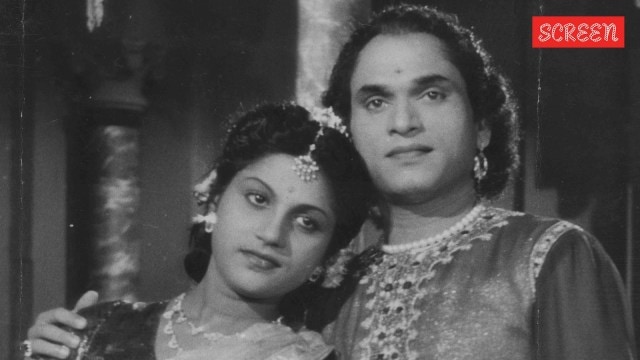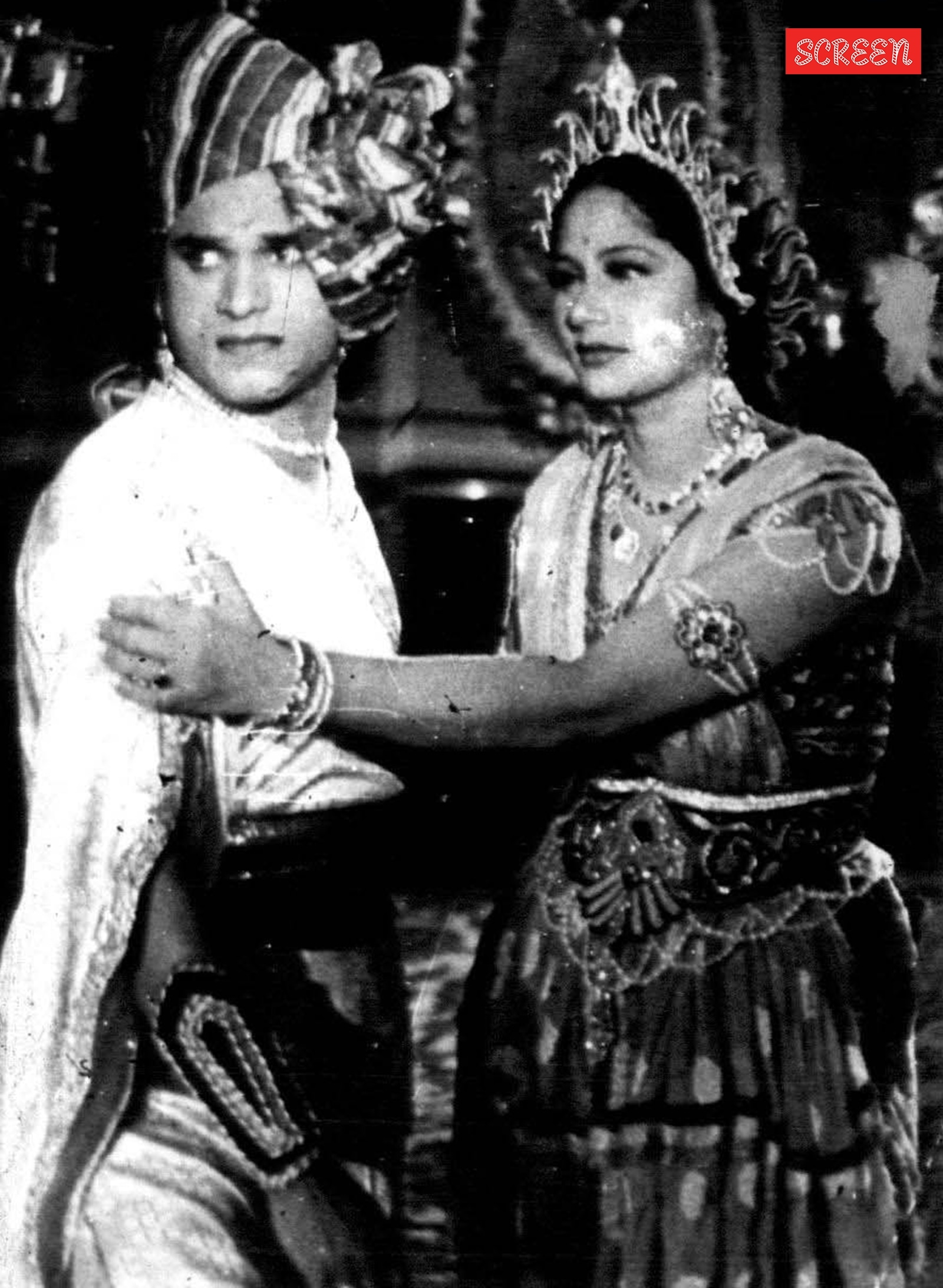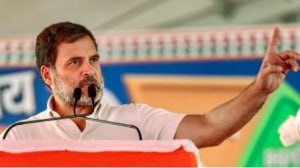Click here to follow Screen Digital on YouTube and stay updated with the latest from the world of cinema.
Tamil cinema’s first superstar dined on gold plates, his film Haridas ran in theatres for 784 days; was jailed for killing journalist
Dulquer Salmaan's upcoming movie Kaantha is reportedly inspired by the life of the 'first superstar of Tamil cinema' MK Thyagaraja Bhagavathar, whose records were surpassed only by Rajinikanth. Jailed in a murder case, he lost his stardom.
 The "first superstar of Tamil cinema" with co-star BS Saroja in their movie Amarakavi. (Express archive photo)
The "first superstar of Tamil cinema" with co-star BS Saroja in their movie Amarakavi. (Express archive photo)With the release of writer-director Selvamani Selvaraj’s Kaantha, starring Dulquer Salmaan in the lead role, right around the corner, the name of one person — whom the current generation of youngsters may not be very familiar with — has resurfaced. Although one might assume that Mayavaram Krishnamurthy Thyagaraja Bhagavathar was just a Carnatic singer, a simple Google search reveals that he was much more than that. In fact, he was one of the most successful lead actors in the history of the Tamil film industry and the “first superstar of Tamil cinema.”
Though he appeared in only a handful of films, most of them were massive successes. Interestingly, one of his movies, Haridas (1944), once held a nearly unbreakable record of running for 114 weeks (about 784 days) in a single theatre — Broadway Cinema in Madras (now Chennai). This record stood for over five decades before being surpassed by “Superstar” Rajinikanth’s Chandramukhi (2005), which reportedly ran for an astounding 890 days at Shanti Theatre in Chennai.
Just imagine; despite Tamil cinema witnessing the arrival and rise of several stars like MG Ramachandran (MGR), Sivaji Ganesan, Gemini Ganesan, Rajinikanth, and Kamal Haasan in subsequent eras, it took almost 59 years for his milestone to be shattered. This underscores the kind of impact he made in Tamil Nadu, despite his career being short and ending most scandalously and tragically. In a way, it can be said that MK Thyagaraja Bhagavathar — known by his initials as MKT — was the most famous and infamous star of the early years of Indian cinema. And if reports and rumours are to be believed, Dulquer Salmaan’s Kaantha is loosely inspired by the life of MKT.
Who was MK Thyagaraja Bhagavathar?
In a series on MKT that legendary film historian Randor Guy penned in The Hindu, it is noted that the actor-singer was born into a family of struggling goldsmiths in Trichy on March 1, 1910. Thyagarajan displayed exceptional talent in singing from a young age and quickly caught the attention of the locals, eventually paving the way for his entry into the world of theatre. He also received formal training in Carnatic music and was honoured with the title “Bhagavathar” by one of his mentors.
 MK Thyagaraja Bhagavathar was born into a family of struggling goldsmiths. (Credit: X/@NFAIOfficial)
MK Thyagaraja Bhagavathar was born into a family of struggling goldsmiths. (Credit: X/@NFAIOfficial)
When his widely successful play Pavalakkodi was adapted into a movie in 1934, the makers did not have to think twice about casting MKT. Thus, he and his renowned stage partner, SD Subbulakshmi, made their movie debut. Featuring as many as 50 songs, Pavalakkodi became a sensation. MKT and Subbulakshmi collaborated with Pavalakkodi’s director K Subramaniam once again and delivered Naveena Sarangadhara (1936), which also fared well. From the massively successful Chintamani (1937) to Ambikapathi (1937), Thiruneelakantar (1940), Ashok Kumar (1941), and Sivakavi (1943), MKT turned whatever he touched into gold. While the rise of MKT was astounding and phenomenal, his fall was even more impactful and shocking.
Lakshmikanthan murder case
At the zenith of his career, MKT found himself embroiled in a highly publicised murder case and was even jailed for many months. The Lakshmikanthan case, thus, remains a controversial chapter in the history of Chennai. Described by Guy as a “notorious yellow journalist,” CN Lakshmikanthan often wrote about the private lives of movie stars and other notable individuals in his publications, Cinema Thoothu and Hindu Nesan. According to a chapter focusing on the Lakshmikanthan case in noted author GR Indugopan’s book Murder In Madras, the self-proclaimed journalist was incarcerated in the Andaman jail from 1932 to 1939 for fraud involving forged documents. Once released from prison, he began targeting the wealthy in the city. Using the basic information gathered from stalking them, he fabricated stories. He then approached the same wealthy victims, threatened them, and extorted money. Stories linking the rich with women apparently had the most market appeal even then.
Although the then-Madras Governor Arthur Oswald James Hope revoked the license of Cinema Thoothu at the request of actresses and other prominent figures in the film industry, Lakshmikanthan retaliated by launching Hindu Nesan. This time, his major targets were MKT, comedian NS Krishnan, and director-producer SM Sriramulu Naidu. Lakshmikanthan frequently wrote gossip stories linking MKT and his co-star, MR Santhanalakshmi. Thus, he became a significant headache for the film industry.
On October 19, 1944, while Lakshmikanthan was returning home, a man named Vadivelu stabbed him in the neck, injuring him. Nagalingam, a proofreader at Hindu Nesan with whom Lakshmikanthan had a falling out, was the apparent mastermind behind the crime. Fortunately, the injury was not fatal, and hence, the police, too, did not take the case seriously. Less than a month later, he was attacked again; but this time, luck was not on Lakshmikanthan’s side.
On November 8, as he was leaving the house of his lawyer after discussing the case against Nagalingam and Vadivelu, Lakshmikanthan was stopped by the duo and stabbed again, this time in the stomach. He was soon admitted to a hospital, but his condition worsened, eventually leading to his death in the early hours of the next day. Following his demise, both Nagalingam and Vadivelu were arrested. According to a report in The Indian Express on November 10 of that year, en route to the hospital, Lakshmikanthan, 50, had stopped at the Vepery police station and lodged a complaint.
‘MKT promised Rs 2,500 for killing Lakshmikanthan’
Soon, the police obtained a letter that discussed the news of Lakshmikanthan’s “elimination.” The sender and recipient were identified. They testified that MKT, Krishnan, and Naidu were involved in the murder and that their trusted associate had carried out the act. The police identified one Jayanandan, who had allegedly fled the murder scene. He was the brother of actress Madhuri and harboured a grudge against Lakshmikanthan for purportedly writing unwarranted things about his sister.
The prosecution made Jayanandan an approver, and he testified that MKT and Krishnan had assured him money to kill Lakshmikanthan and for the subsequent trial. He claimed that he met MKT and Krishnan once, during which the superstar promised him Rs 2,500 as soon as the deed was done. On December 27, 1944, MKT was publicly arrested, two months after the release of his movie Haridas. Krishnan was also soon detained. Although they initially received bail, the court revoked it a few weeks later.
MKT, NS Krishnan get life imprisonment
In court, the defamatory articles published by Lakshmikanthan against MKT and Krishnan, the knife used for stabbing him, the post-mortem report, and Bhagavathar’s account book that indicated he had paid money to several of the accused were presented as evidence. While Naidu was acquitted, the Madras High Court sentenced MKT and Krishnan to life imprisonment on May 3, 1945. Although they filed an appeal, it was to no avail. Consequently, they were imprisoned and served 30 months in jail.
 Thyagaraja Bhagavathar with Pasupuleti Kannamba in the movie Ashok Kumar. (Credit: X/NFAIOfficial)
Thyagaraja Bhagavathar with Pasupuleti Kannamba in the movie Ashok Kumar. (Credit: X/NFAIOfficial)
A philanthropist who never hesitated to make donations for good causes, a large section of his fans and the Tamil population believed that MKT was innocent. Even while in jail, he maintained an attitude of “this is all part of my destiny.” However, Krishnan’s wife, actress VA Madhuram, continued to pursue the case, and eventually, the Madras High Court took it up for hearing again. But this time, the opposite happened. The accused’s lawyer skillfully discredited the prosecution’s witnesses. Due to the weak foundation of the prosecution’s evidence, the court ordered their release, and MKT and Krishnan finally walked free.
MKT’s release from prison, downfall and death
Before his release from prison in 1947, the superstar had already signed a dozen films. However, he never managed to recreate the magic of his pre-controversy era. Movies such as Raja Mukthi (1948), Shyamala, Amarakavi, and Pudhu Vazhvu failed to make a significant impact at the box office. Even his final film, Sivagami (1960) — in which he played the lead role as himself and was released posthumously — did not attract large crowds as his earlier works did.
Although he lost a great deal of money during the trial, MKT’s assets still exceeded those losses. According to Indugopan’s book, he was the first Tamil film professional to own a Mercedes-Benz car. Besides, he used to eat his meals at home on two golden plates, each weighing 110 pavan (sovereigns). At today’s prices, one plate alone would be worth close to Rs 98 lakh. Though his acting career almost ended with Pudhu Vazhvu, and he never had a release in his lifetime after that, he continued to impress the masses as a singer.
MKT breathed his last on November 1, 1959. During his final days, he suffered from high blood pressure and acute diabetes. Despite six decades having passed since his demise, MK Thyagaraja Bhagavathar’s name still shines brightly in the history of both Tamil cinema and Madras.
- 01
- 02
- 03
- 04
- 05


































